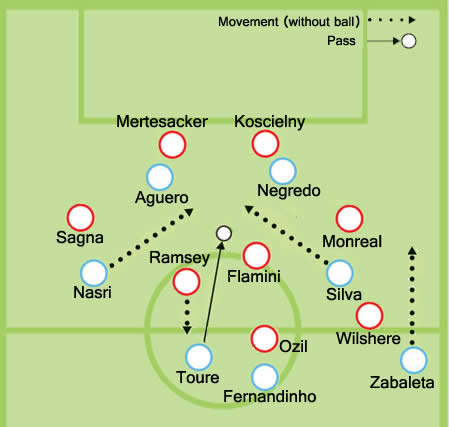Arsenal had equalised not long before, but Manchester City were unperturbed. They merely continued pouring men forward, and when Yaya Toure picked up the ball halfway inside Arsenal’s half, panic ensued. Mathieu Flamini frantically gestured for his team-mates to close Toure down but it was too late when Olivier Giroud sprinted back to challenge him. Toure had already played the ball to Pablo Zabaleta on the right hand side and he was free to cross in for Alvaro Negredo to score. Somehow Laurent Koscielny had injured himself challenging the ball, but that move encapsulated the intoxicating power and speed that Manchester City attacked with.
After the goal, Arsene Wenger called Flamini over, his general on the pitch, and asked him why nobody closed down Toure. Flamini, with his hands on his hips, just nodded, part submissively and part helplessly. The goal took the score to 2-1 and the game, as we know, ended 6-3 to Manchester City.
There is an argument that after half-time Arsenal got a little carried away. They passed the ball breathtakingly at times after the break, but inexplicably tried to go up another level. It echoed their response in the 2nd round against Bayern Munich last year. In that match they were similarly 2-1 down and pushed hard although there was much of the second-half to get the one or two goals that they needed. It’s true that here, Manchester City were there for the taking and Wenger offered little rebuke, instead regret for the way the game ended. While Olivier Giroud spurned three good opportunities before City made it 3-1 but by pushing hard, there was always a chance the tired legs would leave themselves open on the counter and sloppy mistakes were punished.
The performance went against all that has been good about Arsenal this season. The Gunners’ passing has been sharper than in recent years, but what they have really developed is pragmatism. They are able to withstand pressure these days, to hold an opponent at arm’s length, and to break up play when it needs to be done. Crucially, they manage moments better. According to Opta, Arsenal lie eighth in the Premier League for average possession (54.7%) per game: in the last four seasons, they have topped the table. Similarly, they lie in seventh for shots taken per game.
Man City, though, were too strong and dominated much of the match. In the period after half-time, they might have faltered because despite possessing lots of brilliant individuals, City are not a very good defensive side. Still, they get back into shape very quickly as Manuel Pellegrini trains his side to defend with intensity (or “pace” as he says), and with that, and a little bit of luck (as they also survived a good handball appeal) was enough to protect their goal until they scored their third. After that, City were able to pick Arsenal off on the break and take advantage of the fact that The Gunners, growing ever more anxious, were defending with very few players.
In the first-half, there was more of a tactical battle with City dominating the midfield despite setting up in a 4-4-2. However, all formations are neutral; it’s the application that decides their failures and success, and City were able to control the game due to the sheer forward-mindedness of their game. Pellegrini explains: “I have five footballers with an obligation to attack: two strikers, two creative midfielders and one of the full-backs. I’ve always got two players in the rivals’ half to arm our offensive game. The quality has to come from the players.”

It was two creative midfielders, Silva and Nasri, who were key, drifting infield to essentially make it 4v3 in the centre. That then allowed the full-backs to bomb-forward, and Arsenal were overawed. That was the beauty of City’s play; because they attack from all angles, every player on the opposing side is occupied. The wide players are forced to track the full-backs all the way, the central defenders each have a striker to pick up and the central midfielders have to keep their eyes on play developing in front of them and behind them.
Essentially, that was the problem Arsenal had. When Yaya Toure had possession of the ball, Ramsey went out to press him. If he was bypassed by a pass, which he often was, the ball would find its way to Nasri or Silva both isolated against Flamini. This happened frequently and because City played with two up front, one of the centre-backs was unable to push out and sweep up.
The one time it did work, however, Arsenal scored. Ramsey dispossessed Toure on the halfway line and from the quick break-away, Ozil was able to find Walcott to score Arsenal’s first. Ramsey was also influential for Arsenal’s second, lifting the ball over for Walcott again to score. His energy is so crucial to the way Arsenal play but it can’t be denied that Arsenal got their ambitions wrong on this one: they should have dropped off (as they did in a 3-1 pre-season win actually), and defended with a disciplined double pivot. Wenger hinted at that but reserved much of his anger to the front players for not tracking back properly.
In commentary for Arsenal Player, Nigel Winterburn mentioned that the Arsenal players were marking “areas” as opposed to men. With City interchanging so fluidly, the concern was which player to pick up. Arsenal had no answer.


